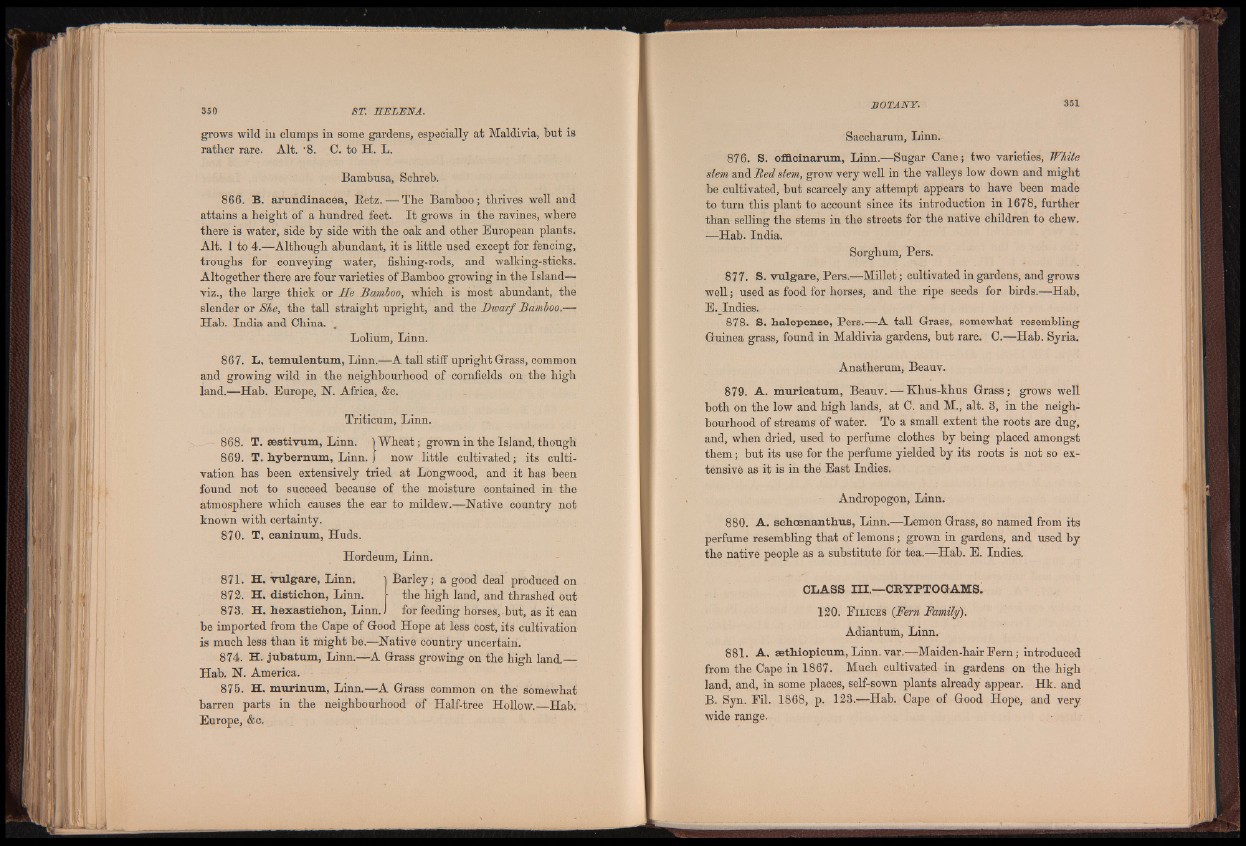
grows wild iu clumps in some gardens, especially at Maldivia, but is
rather rare. Alt. -8. C. to H. L.
Bambusa, Schreb.
866. B. arundinacea, Betz. — The Bamboo; thrives well and
attains a height of a hundred feet. I t grows in the ravines, where
there is water, side by side with the oak and other European plants.
Alt. 1 to 4.—Although abundant, it is little used except for fencing,
troughs for conveying water, fishing-rods, and walking-sticks.
Altogether there are four varieties of Bamboo growing in the Island—
viz., the large thick or Me Bamboo, which is most abundant, the
slender or She, the tall straight upright, and the Dwarf Bamboo.—
Hab. India and China. „
Lolium, Linn.
867. L. temulentum, Linn.—A tall stiff upright Grass, common
and growing wild in the neighbourhood of cornfields on the high
land.—Hab. Europe, N. Africa, &c.
Triticum, Linn.
868. T. sestivum, Linn. ) Wh e at; grown in the Island, though
869. T. hybernum, Linn, j now little cultivated; its cultivation
has been extensively tried at Longwood, and it has been
found not to succeed because of the moisture contained in the
atmosphere which causes the ear to mildew.—Native country not
known with certainty.
870. T, caninum, Huds.
Hordeum, Linn.
871. H. vulgare, Linn.
8 7 2 . H . d i s t i c h o n , L in n .
Barley; a good deal produced on
the high land, and thrashed out
873. H. hexastichon, Linn J for feeding horses,-but, as it can
be imported from the Cape of Good Hope at less cost, its cultivation
is much less than it might be.—Native country uncertain.
874. H. jubatum, Linn.—A Grass growing on the high land.—
Hab. N. America.
875. H. murinum, Linn.—A Grass common on the somewhat
barren parts in the neighbourhood of Half-tree Hollow.—Hab.
Europe, &c.
Saccharum, Linn.
876. S. officinarum, Linn.—Sugar Cane; two varieties, White
stem and Bed stem, grow very well in the valleys low down and might
be cultivated, but scarcely any attempt appears to have been made
to turn this plant to account since its introduction in 1678, further
than selling the stems in the streets for the native children to chew.
—Hab. India.
Sorghum, Per s.
877. S. vulgare, Pers.—Millet; cultivated in gardens, and grows
well; used as food for horses, and the ripe seeds for birds.—Hab,
E.Andies.
878. S. halepense, Pers.—A tall Grass, somewhat resembling
Guinea grass, found in Maldivia gardens, but rare. C.—Hab. Syria.
Anatherum, Beauv.
879. A. muricatum, Beauv. — Khus-khus Grass; grows well
both on the low and high lands, at C. and M., alt. 3, in the neighbourhood
of streams of water. To a small extent the roots are dug,
and, when dried, used to perfume clothes by being placed amongst
them; but its use for the perfume yielded by its roots is not so extensive
as it is in the East Indies.
Andropogon, Linn.
880. A. schcenanthus, Linn.—Lemon Grass, so named from its
perfume resembling that of lemons; grown in gardens, and used by
the native people as a substitute for tea.—Hab. E. Indies.
CLASS III.—CRYPTOGAMS.
120. F ilices {Fern Family).
Adiantum, Linn.
881. A. sethiopicum, Linn. var.—Maiden-hair F e rn ; introduced
from the Cape in 1867. Much cultivated in gardens on the high
land, and, in some places, self-sown plants already appear. Hk. and
B. Syn. Fil. 1868, p. 123.—Hab. Cape of Good Hope, and very
wide range.